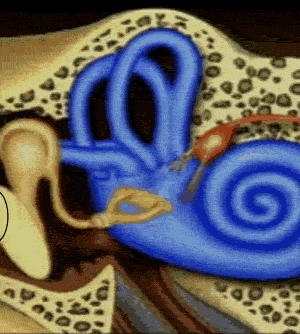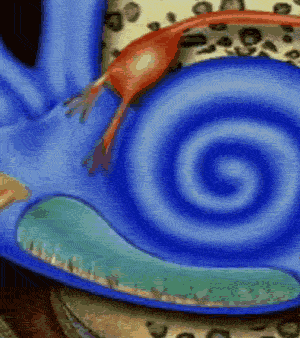|
The
Human Ear |
The human ear is a combination of two separate organs. One organ is for hearing while the other is for balance. But why should two apparently different functioning organs be placed together?
Both hearing and balance depend on the movement of hair-like projections (cilia) protruding from the membrane of nerve cells encased in fluid filled vessels. Although their function is completely different their structure is very similar. |
 |
Sound waves travel through the air and press up against the eardrum, as shown on the right.This causes the eardrum to vibrate which in turn causes the vibrations to pass through to the fluid in the cochlea via three small bones known as the hammer (malleus), anvil (incus) and stirrup (stapes).
|
 |
| The way the hammer, anvil and stirrup are arranged causes an amplification of the external vibrations. The stirrup is attached to the external membrane of the cochlea and movements of this bone cause pressure waves to form in the fluid within the cochlea. |
 |
Inside the cochlea vibrations traveling through the fluid cause thousands of hair like structure, called cilia, to vibrate backwards and forwards. The nerve cells with the cilia convert vibrations into electrical signals that travel to the brain.
Loud noises tend to create bigger waves in the fluid of the cochlea. Big waves tend to cause vigorous fluid movement and tilt the cilia to one side more. As a consequence the nerve cell fires signal to the brain at a greater frequency. |
 |
| High frequency vibrations are processed in the front part of the cochlea while low frequency vibrations are processed deep in the cochlea, as shown on the right. Loud and persistent noise tends to cause the death of the cilia at the front of the cochlea. People that attend loud rock concerts tend to have problems processing high pitched noise. |
 |
| What are two functions of the hammer, anvil and stirrup? |
| Why does a throat infection often spread to the ear? |
| What is similar between the sensory organs involved in hearing and those involved in balance? |
| How does the ear differentiate between loud noise and quiet noise? |
| What is Meniere's disease? |
| What causes motion sickness? |
| Why are people who are exposed to loud noise not able to hear high pitched sounds? |
Pick a question that relates to the ear, do not select the ones above. Research and answer the question in a mini project. Here are some starters
How can I burst my eardrum and can it be repaired?
What is ear wax and does it have a purpose?
Why can dogs hear sounds that humans can not?
|
|




